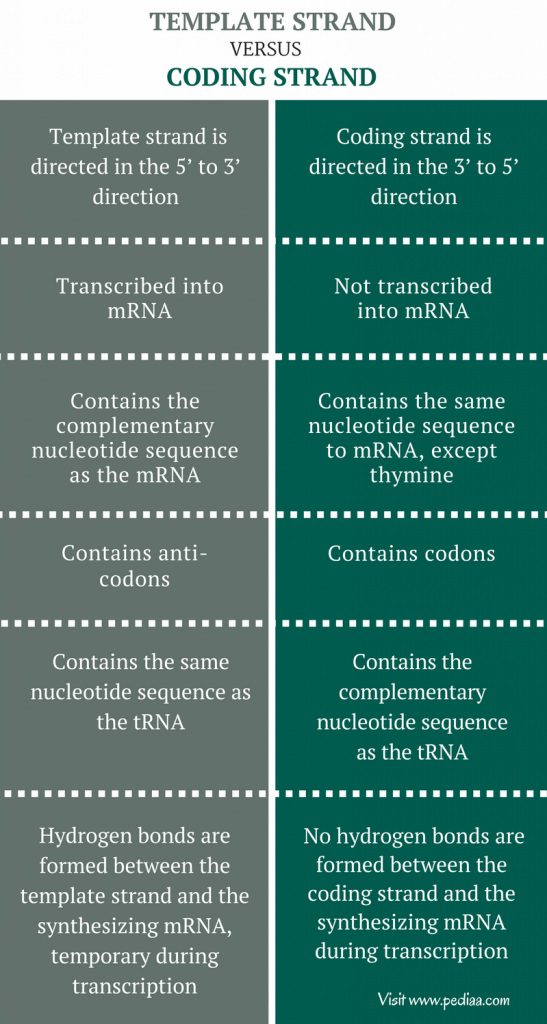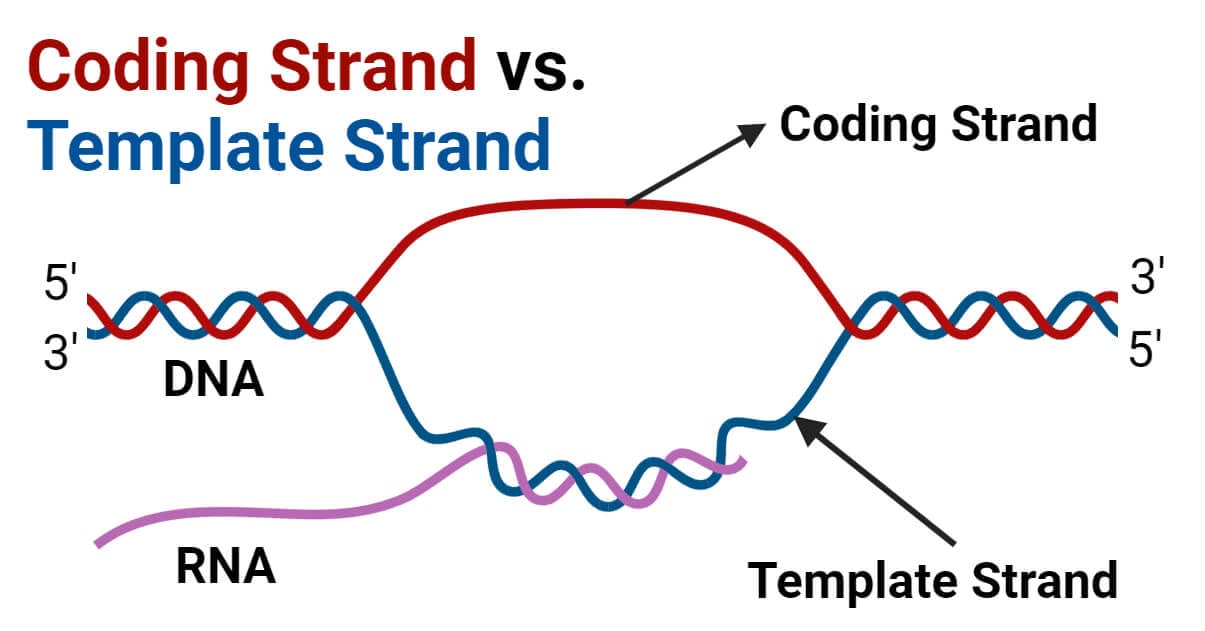Template Coding Strand
Template Coding Strand - Web the template strand is the one that rna polymerase uses as the basis to build the rna. The dna strand known as the template strand serves as a blueprint for the production of rna, whereas the coding strand is the other strand. Web the main difference between template and coding strand is that template strand only serves as the template for transcription whereas coding strand contains the exact same sequence of nucleotides in the mrna except thymine. This way, both strands work together, ensuring the right information is transferred from dna to rna. Web the coding strand is typically located on the 5' to 3' direction, while the template strand is located on the 3' to 5' direction. Web the coding strand provides a reference for the formation of mrna with a similar sequence, while the template strand guides the rna polymerase to synthesize a complementary rna strand. The template contains anticodons, while coding involves codons. Web if you're seeing this message, it means we're having trouble loading external resources on our website. This occurs as individual nucleotides hydrogen bond to the dna template strand according to the rules described in conceptual question c12. The template strand is usually directed 3’ to 5’ in direction. During transcription, both strands of the gene being transcribed have different names and different roles. The coding strand functions to determine the correct nucleotide base sequence of the rna strand. The template contains anticodons, while coding involves codons. Hydrogen bonds form between the template and the new mrna during transcription. Web the coding strand provides a reference for the formation of mrna with a similar sequence, while the template strand guides the rna polymerase to synthesize a complementary rna strand. In the intricate realm of molecular biology, the concept of dna strands plays a pivotal role, especially when it comes to transcription and translation processes. Web the coding strand determines the correct nucleotide sequence of mrna. Web the strand of dna from which mrna is formed after transcription is known as the template strand or the antisense strand. Web one strand of the dna, the template strand (or noncoding strand), is used as a template for rna synthesis. Web coding strand vs. Web if you're seeing this message, it means we're having trouble loading external resources on our website. It is also known as sense strand (plus strand) or coding strand. Web the template strand is the one that rna polymerase uses as the basis to build the rna. Two key players in this genetic orchestra are the coding strand and the. Web within the open complex, one of the dna strands, the one running in the 3′ to 5′ direction, is used as template for rna synthesis. During transcription, both strands of the gene being transcribed have different names and different roles. Web the coding strand determines the correct nucleotide sequence of mrna. The coding strand or the sense strand corresponds. The template strand is usually directed 3’ to 5’ in direction. The template strand acts as a base for mrna transcription. This structural difference ensures that the rna transcript is synthesized in the correct orientation and matches the. It is the antisense strand (minus strand) or a. This template strand is called the noncoding strand. Web the main difference between template and coding strand is that template strand only serves as the template for transcription whereas coding strand contains the exact same sequence of nucleotides in the mrna except thymine. The strand that actually serves as the template on which rna is polymerized is properly referred to as the template strand. Web the coding strand. During transcription, both strands of the gene being transcribed have different names and different roles. By convention, the coding strand is the strand used when displaying a dna sequence. This template strand is called the noncoding strand. It is the antisense strand (minus strand) or a. In the intricate realm of molecular biology, the concept of dna strands plays a. The strand that actually serves as the template on which rna is polymerized is properly referred to as the template strand. This template strand is called the noncoding strand. Web the strand of dna from which mrna is formed after transcription is known as the template strand or the antisense strand. Web the coding strand determines the correct nucleotide sequence. If guanine (g) is encoded in the template strand, then. Web template strand functions as a base for the rna synthesis. As transcription proceeds, rna polymerase traverses the template strand and uses base pairing complementarity with the dna template to create an rna copy (which elongates during the traversal). By convention, the coding strand is the strand used when displaying. It is the antisense strand (minus strand) or a. This template strand is called the noncoding strand. Web the template strand is the one that rna polymerase uses as the basis to build the rna. The template strand acts as a base for mrna transcription. Web one strand of the dna, the template strand (or noncoding strand), is used as. The dna strand known as the template strand serves as a blueprint for the production of rna, whereas the coding strand is the other strand. By convention, the coding strand is the strand used when displaying a dna sequence. Web the strand of dna from which mrna is formed after transcription is known as the template strand or the antisense. Web the coding strand provides a reference for the formation of mrna with a similar sequence, while the template strand guides the rna polymerase to synthesize a complementary rna strand. Hydrogen bonds form between the template and the new mrna during transcription. Web the template strand serves as a template for rna synthesis, i.e., if adenine (a) is encoded in. The coding strand functions to determine the correct nucleotide base sequence of the rna strand. Web template strand functions as a base for the rna synthesis. The template strand is usually directed 3’ to 5’ in direction. Web the template strand goes in one direction, while the coding strand goes in the opposite direction. The template strand acts as a base for mrna transcription. Web the main difference between template and coding strand is that template strand only serves as the template for transcription whereas coding strand contains the exact same sequence of nucleotides in the mrna except thymine. The dna strand known as the template strand serves as a blueprint for the production of rna, whereas the coding strand is the other strand. As transcription proceeds, rna polymerase traverses the template strand and uses base pairing complementarity with the dna template to create an rna copy (which elongates during the traversal). Web it is the strand of dna that does not directly code for a protein but complementarily pairs with the code so it can be used as a template upon which to build mrna with the correct code. In the intricate realm of molecular biology, the concept of dna strands plays a pivotal role, especially when it comes to transcription and translation processes. This occurs as individual nucleotides hydrogen bond to the dna template strand according to the rules described in conceptual question c12. Web the template strand serves as a template for rna synthesis, i.e., if adenine (a) is encoded in the template strand, uracil (u) will be encoded in the newly synthesized rna. This template strand is called the noncoding strand. Web if you're seeing this message, it means we're having trouble loading external resources on our website. Web the coding strand determines the correct nucleotide sequence of mrna. By convention, the coding strand is the strand used when displaying a dna sequence.Difference Between Template and Coding Strand
Coding Strand vs. Template Strand 6 Key Differences
Template And Coding Strand Of Dna
Coding Strand Template Strand Mrna
Is The Coding Strand The Template Strand
Template vs. Nontemplate (Noncoding vs. Coding strand of DNA) YouTube
How To Identify Template Strand Of Dna
Difference Between Template and Coding Strand
Coding Strand And Template Strand
Template and coding strands of DNA YouTube
This Structural Difference Ensures That The Rna Transcript Is Synthesized In The Correct Orientation And Matches The.
The Coding Strand Or The Sense Strand Corresponds To The Same Sequence As That Of The Mrna Strand.
Web One Strand Of The Dna, The Template Strand (Or Noncoding Strand), Is Used As A Template For Rna Synthesis.
It Is The Antisense Strand (Minus Strand) Or A.
Related Post:









